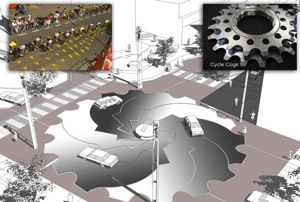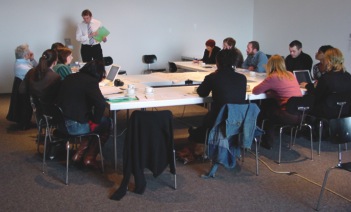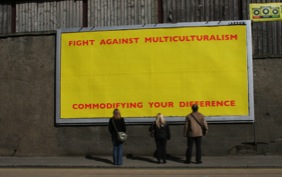Improving the understanding of arts function for social benefit through the development and delivery of public art projects in the public domain
Submitting Institution
Loughborough UniversityUnit of Assessment
Art and Design: History, Practice and TheorySummary Impact Type
SocietalResearch Subject Area(s)
Studies In Creative Arts and Writing: Art Theory and Criticism, Visual Arts and Crafts
Language, Communication and Culture: Cultural Studies
Summary of the impact
The impact of this case study is the evidence that public art can
function for social benefit. Significant research projects were completed
for Ashford, commissioned by Kent County Council (2010), New Art Gallery
Walsall (2005 - 2009), Collective Gallery Edinburgh, UK (2008), Liverpool
Biennale (2010). This research claims three types of impact: 1. Public
Service: a public artwork as part of a shared traffic scheme, which
demonstrates a reduction in traffic accidents, 2. Civil Society:
participatory artworks that enable public engagement in the design of a
place (Ashford & the Black Country) , and 3. Influencing Policy — making: a contribution to policy debates concerning public art's function
for social and economic regeneration.
 1. Notaroundabout, Project Atkin, J
1. Notaroundabout, Project Atkin, J
 2. Futurology Project artist meeting Borough Council planning office,
Jordan, M
2. Futurology Project artist meeting Borough Council planning office,
Jordan, M
 3. How to be Collective, Project participants talking back to artworks,
Jordan, M
3. How to be Collective, Project participants talking back to artworks,
Jordan, M
Underpinning research
Researchers: John Atkin, Reader in Fine Art, Loughborough University,
1992-..; Mel Jordan, Reader in Fine Art, Loughborough University, 2007-..;
This research is developed from the long-term preoccupation of Atkin and
Jordan with regard to the relevance and importance of public art for
cultural life and civil society. The underpinning research addresses arts
function for social and cultural benefit, examining arts role in public
engagement and its purpose in urban regeneration.
The outcomes of practice-based research are artworks, exhibitions and
projects in the public realm that are funded by UK Government's
Sustainable Communities Plan, Kent County Council, Arts Council England,
Black Country Consortium, Scottish Art Council, AHRC and Creative
Partnerships. These provide significant examples of the way art can be
developed for public spaces and enable public dialogues, more recent work
is on the evaluation of art projects for social and cultural benefit.
Atkin's research (with Landscape Architects Whitelaw and Turkington) is
the first in the UK to implement a shared space scheme with both an
extensive consultation and integrated design team. The Notaroundabout
artwork addresses art's use and function in the planning and development
of public space as well as putting the users of the space at the centre of
the design process [3.1]. Jordan's research [3.2] proposes
new models of participatory art practice with the aim of engendering more
democratic exchange between artists, volunteers, curators, commissioners
and audiences (Civil Society).
The Notaroundabout project was unique in that it employed two
methods of integration; shared space (between traffic and pedestrians) and
extensive user consultation (between users and planners). The public art
enabled a dialogue between numbers of different constituents. Atkin tested
materials in specialist Kent County Council KCC /Jacobs laboratories to
examine the suitability of Highway's materials for set purposes, i.e. slip
testing of slabs for the Notaroundabout paving design. The
research explored how the use of bespoke materials used in the fabrication
of Notaroundabout could address the desired aims of reducing
street furniture clutter for the new development and negate the use of
unnecessary signage, associated with common practice in Highway Design
protocols [3.3].
Jordan's research (with co-investigators Dave Beech, Chelsea College of
Art and Dr. Andy Hewitt University of Wolverhampton) has fore fronted the
application of public sphere theory to the practice of participatory arts
in order to investigate the relationship between art and its publics [3.4].
As a result, it has enabled a new articulation and understanding of public
art's impact upon community cohesion, in particular via processes of
participation (AHRC award to Jordan detailed in section 3) and has
therefore embraced arts role as part of civil society. The outcome of the
research is an original way to consider the relationship between art and
its audiences. Exhibitions include, How to be Hospitable, Futurology The
Black Country: 2024, Every Shop Window is a Soap-box.
The research has been commissioned by leading organisations and reviewed
by foremost critics and mentioned by Arts Council England as part of the
reflection upon arts social function. A wide range of publics has engaged
with these projects, which were carried out, in the public realm.
References to the research
3.1. Atkin. J. Notaroundabout. 2010. Public Art commission
commissioned by Kent County Council. Lead Artist in the Interdisciplinary
Design Team (IDT)' Breaking Boundaries', Ashford £15M multi-award winning
Ring Road Highways regeneration project. Media of output: one large-scale
interactive public sculpture/highway/plaza space
3.2. Jordan, M., Beech, D. and Hewitt, A., (2008a). How to
be Hospitable. Solo exhibition for Freee art collective
(Jordan et al.), commissioned by Kate Gray for the Collective
Gallery, Edinburgh. 4 April-17 May 2008. Media of output: five billboard
posters
3.3. Atkin. J. Public Space. Breaking Boundaries. The Ashford Ring
Road. Kent. For the conference Understanding the Post Industrial City:
Metropolis, Urban Renewal and Public Space, a joint research
exchange programme on post-industrial urbanism between the
Bauhaus-Universität Weimar and the Technical University Lisbon, Portugal
2009
Quality indicators: Jordan's research outcomes (artworks) have been
commissioned by leading arts organisations, including the Collective
Gallery, The New Art Gallery Walsall and the Liverpool Biennial. In 2009
Jordan was approached by Intellect to develop a new journal, Art & the
Public Sphere. Atkin has received a number of invitations to speak about
the Notaroundabout project; such as Distinguished Guest: 3rd World
Sculpture Conference. Venue: Jilin College of the Arts. Changchun. PRP
China and as a keynote speaker for the conference Understanding the Post
Industrial City: Metropolis, Urban Renewal and Public Space, a joint
research exchange programme on post-industrial urbanism between the
Bauhaus-Universität Weimar and the Technical University Lisbon, Portugal
2009.
Prizes: Atkin, J. — Design 1-5 hectares Award: Highly Commended,
Landscape Institute. Atkin, J. Prime Minister's Award for best building — Finalist 2009
| When |
What |
Collaborators |
Researchers |
Funder/Value of project |
| 2004 - 2009 |
Futurology: The Black Country 2024 |
New Art Gallery Walsall
Schools x 5 Creative Partnerships |
Jordan, +
(A.Hewiit) |
£100,000
Arts Council England, Creative Partnerships &
Black Country Consortium |
| 2005 - 2010 |
Notaroundabout ( Breaking Boundaries project) |
Architects |
Atkin |
£120000 |
| 2008-2011 |
How to be hospitable |
Collective Gallery |
Jordan
(A.Hewitt & D, Beech |
£6,000, Scottish Art Council |
| 2010 |
Every Shop Window is a soapbox |
Liverpool Biennale |
Jordan
(A.Hewitt & D, Beech |
Liverpool Biennial £5,000 Commision |
| 2011 |
The Resilience & Regeneration potential of
Creative Arts communities in an Age of Austerity’. |
Lees,L
Pratt, A
Miles, M |
Jordan |
AHRC £16,000 for developmental research |
Details of the impact
(Impact 1 Public Service: Public artwork reduction in traffic accidents)
In May 2012, Kent County Council published a statistical report on the
`Breaking Boundaries' shared space scheme. The report provides statistical
analysis on safety for the three years prior to the project (2004 to 2006)
and three years after project completion (2008 to 2011). In this document,
safety is statistically defined by: personal injury crashes, casualties
(involving pedestrians, cycles), and the number of vehicles involved.
"The Ashford ring road scheme... has achieved a 41% reduction in crashes
involving personal injuries overall, and a 63% reduction in those
involving pedestrians. Within the Shared Space itself, the reductions are
50% and 83% respectively." White, Bob (2012) [5.1]
Statistical evidence supports the view that vehicular and pedestrian
traffic benefit from the implementation of this shared space scheme in
Ashford. The neighbourhoods either side of what was the ring road now have
a shared space allowing them access to the town rather than a dual
carriageway separating them from the town. The community is now rid of
railings, subways and limited designated spaces for crossing a busy
highway, for a 20 mph shared space, allowing them to access the town from
a variety of vantage points.
(Impact 2: Civil Society: Participatory public artworks that enable
critical public engagement and demonstrates arts role in the creation of
civil society)
Jordan, (with Beech and Hewitt) developed a solo exhibition commissioned
by the Collective Gallery Edinburgh, UK. The exhibition, titled How to
be Hospitable, included five new artworks and a documentary video of
the participants who had participated in its creation. The exhibition was
one of five off-site projects that sought to engage new audiences and
communities within a one-mile radius of the gallery. In evaluating its
achievements The Scottish Arts Council concluded that, "The Freee art
collective's (Jordan, Beech and Hewitt) exhibition, under the aegis of
the One Mile programme, is a laudable attempt to engage new audiences
and communities via innovative and experimental projects" Stephen
Beddoe (ACS Report, 2008) [5.2].
Futurology: The Black Country 2024 makes a material contribution
to public awareness and participatory practice, as its creation was a
participatory art project, in which artists, theorists and young people
collaborated to examine the current social, economic and political
conditions in the Black Country in order to imagine their futures. The
premise of the research was to create a new relationship between leaders
of the regeneration project in the Black Country and those affected by
this planning scheme; the project operated as a forum in which all
stakeholders contributed. Five schools took part in the project, and each
school was allocated an artist to work with. Together with New Art
Gallery, Walsall, the project was funded by Creative Partnerships, whose
evaluation report stated:
"The influence of the artist changed the way the students thought
about their area and the potential for change. It had also clearly led
them to identify and reflect upon others' complacency, not as a fault,
but as being born out of having not had such stimulus.". (Hall,
2005). [5.3]
(Impact 3. Influencing Policy — making: a contribution to policy debates
concerning public art's function for social and economic regeneration. ).
Futurology: The Black Country 2024 achieved influence on public
policy debates, as Jordan spoke about the methods that were devised in the
project at the symposium `Space to think — Does every child matter in
socially engaged practice? What does true collaboration with young
people look like?'. This Creative Partnerships seminar was promoted
as a `space to think' and a forum for representatives from the creative,
cultural, education sectors and business to discuss a broad range of
issues concerning creativity and learning [5.4], [5.5].
Atkin as one of the Integrated Design Team (IDT) defined process and
research through meetings and workshops, (2005 - 2010), including
community consultation and mentoring schemes. The level of impact was
achieved by establishing an Integrated Design Team (IDT) at the point of
project ignition. Artists, highway engineers, landscape architects,
lighting designers, traffic planners and urban designers all worked
together to deliver the artistic, pragmatic, legal and functional aspects
of the project. Thus ensuring delivery of a cohesive series of public
realm spaces, following the principles of sharing space equally between
pedestrians, cyclists and motorists.
Atkin (et al) established a Champions Group (CG) comprising IDT members
as well as representatives from Ashford's Future to look at the commercial
and business component of the project. The CG also comprised members of
Ashford Borough Council (ABC): Disability Groups: Community
representation: Sustainability representation: Emergency Service
representation. The CG met once a month with agenda items evaluating
progress of the scheme and forward planning actions.
Sources to corroborate the impact
The following sources of corroboration can be made available at request.
5.1. Ashford Ring Road Three-Year Report. 2012. Kent County
Council.
http://www.roadsafetygb.org.uk/news/908.html
website accessed 19-6-2012,
5.2. Arts Council Scotland Report (2008)
5.3. Futurology Project Evaluation Report. Commissioned by
Creative Partnerships
5.4. Holding the Reins: Equality, Meaning and Cultural Capital'
Roz Hall, Engage Journal 27 Exchange.
5.5. Letter from Senior Arts Council Officer, Arts Council England